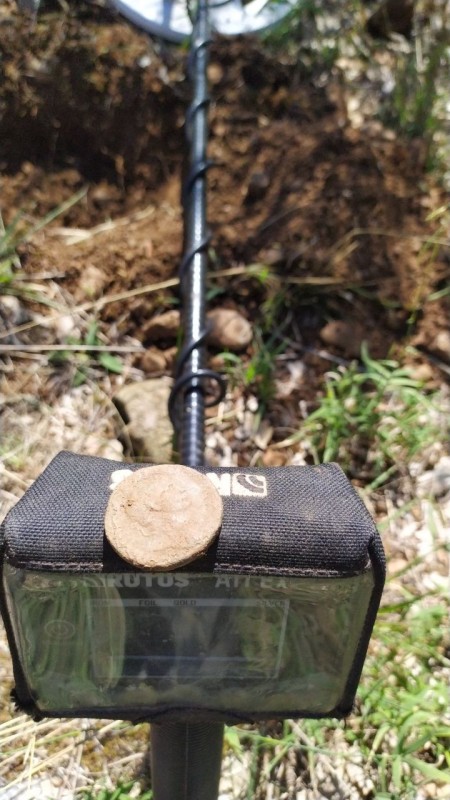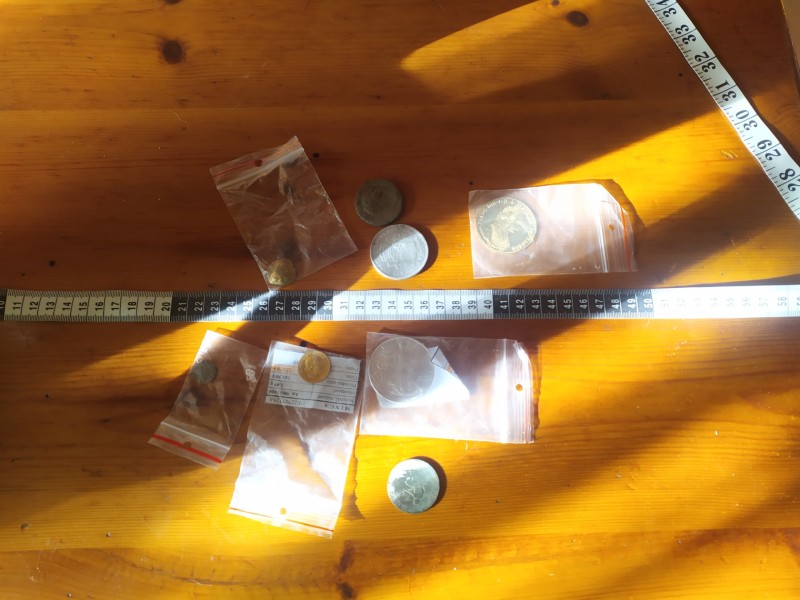-
Posts
1,353 -
Joined
-
Last visited
Content Type
Forums
Detector Prospector Home
Detector Database
Downloads
Everything posted by EL NINO77
-
X-terra Pro..I was interested in the beach program...I think this program can have a multi-frequency element?.. /elimination of terrain-water conductivity?/ ....other programs can run on one selectable frequency....it is such a competition to Deus1/ORX...but also to other detector manufacturers... Personally, I think this is how the first Vanquish should have looked... The shape of the coils is identical to the one from the Vanquish line...so now I have a question...will the Vanquish and XTerra Pro coils be compatible?.. ...never underestimate single frequency detectors.... the ratio of my gold coins found by single frequency detector to multi frequency detector... is 11 gold coins for 1F frequency detectors... and 7 gold coins for Multifrequency detectors...
-

Deus 2 Vs Manticore. Relic Hunting In Hot Dirt.
EL NINO77 replied to Daniel Tn's topic in Metal Detector Advice & Comparisons
Jeff the question is ... what does Steve mean by the word ... "small non-ferrous materials" ... ist 0.1 gram, 0.3 gram?, 0.5 gram.., or something just under 1 gram gold ? For example, in my tests on a very small earring made of white 18K gold /very demanding target/ the 9" HF coil does not increase the range when using 30/54 khz on this earring, the range is 1.5cm max - but the signal quality improves.. With a small elliptical 5.5x9.5 HF coil, the range is already linearly greater ....-according to the higher frequency used... so I feel that the 9" coil - Deus2. can work similarly... -

Whats In Closet Number One?
EL NINO77 replied to George Kinsey's topic in Metal Detecting For Coins & Relics
George...I believe I have a similar view on this hobby.. as you... .Alone.. I have 26 Detectors...+coils.... I completely understand you.... even if the development of detectors is moving forward.... each of these detectors has its own detection logic... and it can be really good in some situations ...especially in combination with a good coil.. Detectors : 4x Garrett,5x Whites,5x Rutus,4x Minelab, 1xAKA, 3x XP, 1xTesoro, 1xDeeptech..,1x Fisher/Teknetics, 1xGolden Mask, .. will also come.. 27..? we will see... I like the detection options..and the detection philosophy of various manufacturers...as well as I see their pluses..and possibly also disadvantages..in detection..compared to other detectors..-signal quality, audio, discrimination quality and VDI accuracy, for example - even in separation... This also makes you think ... how can the new detectors be further improved, which are starting to be really very universal.. ..but many times it turns out..that even an older detector with the right coil... continues to meet really well the deep requirements for a current performance detector... For example... my first detector..... which I had the opportunity to use and detect../in 2011 year/ for some time... and now mine is -Garrett GTI 2500.. https://www.youtube.com/shorts/-xbivYJYP_8 -
Wireless coil, wireless RC Unit, and wireless WS headphones/ and wireless pinpointer / are an important attribute of the XP Company in the Deus1-2/ORX detectors about how a modern detector should look and work. It's hard to object to such a procedure, if such a detector is technically successful..., and works really well... and this procedure makes it possible to make a really lightweight detector... the only disadvantage may be that the coils are more expensive than classic coils with a cable... on the other hand, the same procedure allows you to easily make a lite version of the detector where only the coil and the WS4-6 headphone module are needed... Even though I own many high-end detectors whit cable coils - where I strongly value the truly universal possibility of using affordable additional coils... which makes it possible to significantly strengthen the already good detection properties of these detectors.. .... simply wired and wireless coils have their pluses and minuses.. but each of these options can be used well..
-
Rattlehead......How would you compare the CTX3030 with the large 13x17" coil to the Manticore with the 11" coil? That question...really...is...drilling...in my head.. Otherwise... You have nice videos of detection and testing of detectors in real detection... and immediately after that you dig up the target... which I like very much... and I consider it really correct and fair... 👍 ...Thank you for your review of the Manticore after 50 hours... and its evaluation in detection because I am a strong supporter of the use of increased TX on detectors... as a significant element of improving the depth of detection especially with multi-frequency detectors..
-
I'm typing it on the Vanquish/Equinox 800/600 multi tech.......now as a new X-terra model..that would cover Minelab's entire line of detectors...except for the Go find model line which can also be modified to a multi tech ...Vanquish .... ....the sliding handle system itself in the new X terra is from the Vanquish model. - it is from the Vanquish model line....
-
Another one of the basic principles in increasing the TX performance... is certainly the reduction of the gain in the receiving part of the RX signal... and then the detector can work effectively even in relatively strongly mineralized soil... I had no problem running the Whites Spectra V3 in mineralized soil /6-bar/ with TX boost ON and a very low RX gain of 1-2 max!!!.. with really good detection results... Another advantage when increasing the TX is... that some types of terrain can greatly dampen the transmitting TX signal... ,, and increasing the RX gain itself "has no effect.. because from the very increase of RX gain on the receiving coil .. .of course you also increase the earth's mineralization response and Emi's response... I will give an example with the Whites Spectra V3... where when the TX boost is turned on, the detection properties of this detector can be improved very significantly... in a certain area... and which you will never achieve when using TX Normal... Now to the sensitivity setting for Manticore, which has settings up to 35 max.... Keep in mind that the Manticore will also use smaller coils than the standard 11" coil... and therefore it is possible that on smaller coils you will be able to set a slightly higher sensitivity than is possible with an 11" standard coil in the given terrain... I say so from experience with Equinox and other detectors I own...
-

Which Frequency Is Running In Each Mode?
EL NINO77 replied to vive equinox's topic in Minelab Equinox Forum
GB_Amateur... yes, you are right... to measure the actual working frequencies of multi-frequency detectors, I use an oscilloscope with the possibility of measuring with the help of FFT, on the condition that you measure the actual TX current of the test detector, and not the TX voltage... of the detector... this is how you get the truth information about the frequencies at which the multi-frequency detector really works. In this way, you can even compare quite accurately, for example, how Etrac and CTX work on their different channels 1-11/ shift of working frequencies in multi-frequency .. where you will find that the difference of the highest frequency between the lowest channel 1 and the highest channel 11 is at the upper working frequency of up to 5 khz.. /23khz vs 28khz/.. and that's why the opinion of some detectorists... who claim that channel 11 is the most sensitive to small gold... can be true. ....And now to the test itself, where I wanted to check one thing and specifically that... it seemed to me that the CTX in some field depth tests on the test field that I know... had a better range on the 50 euro cent coin at 35 cm... than on a similar size.. silver coin at the same depth... On the test image..blue marked 50 euro cent, gray marked silver coin... similar and the same size as 50 euro cent... .....This matches my colleague Mike's tests....on his test field for these coins.. silver coin at depht 35cm 50 eurocent a depht 35cm -

Which Frequency Is Running In Each Mode?
EL NINO77 replied to vive equinox's topic in Minelab Equinox Forum
I did the following CTX test on a large 13x17" large coil.. in the Coin program at sensitivity 20... which was aimed at comparing the range between high-medium conductive/a large 24K gold coin the size of a silver dollar and a 50 euro cent - the size of a silver quarter/ .....and highly conductive silver Coins of various sizes.. such as Dollar, Half Dollar, Quarter dollar, and American silver Dime... I supplemented this test with 2 low-conductivity targets: a 5-gram gold stater - made of an alloy of gold and silver/electrum/ and an American 5-cent nickel coin.. -

Tesoro Mojave Vs Silver Sabre Umax?
EL NINO77 replied to NCtoad's topic in Compass, D-Tex, Tesoro, Etc.
Kac...Thank you very much for the explanation.. about the tesoro circuits..... I want to add one more important thing... Mojave can be used on concentric coils 5.75" CC and 7" CC .. even on very mineralized 6-7 BAR Fe3o4 terrain.. / Measured on ...Teknetics G2/ ...if you have the mineralization switch set to High.., with a good signal and reach for silver Dime to a depth of 4"-4.5".. Mojave on the SEF 6x8"DD coil can work on such mineralized terrain ..even on setting the GB switch to "Low mineralization".. with a good signal ..on Dime at 4.5" with a border signal at a depth of 5" .. I want to say that I consider Mojave to be a sufficiently universal detector for various mineralized terrain. -

M8 & M15 Coils Price And Availability?
EL NINO77 replied to Ringtail's topic in Minelab Manticore Forum
...The availability of additional coils on the Manticore is calculated for the 2nd quarter of this year 2023...for central Europe... -

Which Frequency Is Running In Each Mode?
EL NINO77 replied to vive equinox's topic in Minelab Equinox Forum
Carl... Thank you for this information.. it is very valuable...👍🏆.. Just... the main motivation... for my testing was to find out whether today's modern detectors are really sufficiently optimized for large highly conductive coins... because a difference of 7-8 centimeters in range represents "several times stronger signal response" .. for a large gold coins... vs.. an equally large Silver Dollar coin .. ... But it can be seen that there are still reserves in the use of really low working frequencies somewhere around 1 Khz to 1.5 khz... which could be successfully used to detect deep signals... highly conductive coins... my CTX3030 multifrequency measurement:, the lowest used frequency of CTX is 3.3 khz and the highest used frequency is around 25 khz -

Which Frequency Is Running In Each Mode?
EL NINO77 replied to vive equinox's topic in Minelab Equinox Forum
test CTX 3030 : In this test, it is nice to see that the thick highly conductive Roman AS coin has a significantly smaller range than the large gold coin of 4 ducats... during the CTX test, I used the Coin program and sensitivity 20, 22, 23, 24, 25 to see how the range of coins changes with sensitivity...coin reach is measured in centimeters.... -------------------------------------------------------------- Test Equinox 800 : On the Equinox 800 test, it is also nice to see how the reach of individual coins differs from the used 1 frequency.., the multi-frequency balances these differences more..but it is still clear that the highly conductive Roman AS has a smaller range than a large gold coin..coin reach is measured in centimeters.... v you can see the significant differences in range between one frequency 4 khz and 40 khz on large gold coins 4 ducats and Roman AS... where the difference in range is up to 30%!!! setting "recovery speed 3 ,iron bias 0, sens 20.. -

Which Frequency Is Running In Each Mode?
EL NINO77 replied to vive equinox's topic in Minelab Equinox Forum
....The purpose of this test was to find out how different detectors cope with high-conductivity coin type targets for deep detection... I recently had the opportunity to buy a CTX 3030 with a standard 11" coil and a large 13x17" coil at a very good price after tests on my test field where I have it buried higher a medium-conductive 50 euro cent coin at 37 cm with good results, I was curious how the test detector would cope with the other detectors I currently have with me Equinox, CTX, Atrex and ORX in tests for gold and high-conductivity silver coins... and high-conductivity Roman AS../coin/ Of course, I expected that the range of the CTX *3030 detector would be the greatest right on highly conductive coins... but as it turned out... the greatest range was right on a large 40 mm -14 gram 24 gold coin.. that surprised me a bit and that's why I tested the Equinox similarly on the multi programs Park1 and Park2 ... also on one frequency 4khz, 5khz, 10khz, 15khz, 20khz and 40khz... -

Which Frequency Is Running In Each Mode?
EL NINO77 replied to vive equinox's topic in Minelab Equinox Forum
..GB_Amateur..... Yes .. you are right... I used 2 large silver coins in the test... namely 1 Silver dollar/investment coin/ with high purity silver 999/1000.. and for comparison also a large 37mm Spanish Silver coin 5 pesetas 1891.. of purity 900/1000..for verification..to check the results of the test..for highly conductive coins..but what is important is the results of the test range for these highly conductive coins were practically the same... The next highly conductive coin in the test was a rough larger Roman AS coin... because I was interested in how the range of such a coin would change depending on the used frequency or the use of a differently weighted multi-frequency. Now to ... the large 40mm gold coin 4-Dukat 1915..-weight 14 grams.. /size of a Silver Dollar/...this gold coin has a fineness of 0.986/1000 ..which is practically 24k gold... .....And that's exactly why I was interested in how this large pure gold coin fares against other 2 gold coins - 20mm gold Dukat coin 1915 986/1000- 3.5 gram 24K .. gold and above all against the very old 2000 year -5 gram Celtic coin of the Stater - which is probably a gold alloy with the addition of silver /electrum /.. ...for completeness..I supplemented this test with various other coins-- in order to get a complete overview.. about ...how big a difference in range the set high and low frequency can make for these types of coins.. Take my test with a margin...,,,but take into account one fact...namely...that for large silver coins or thick copper coins of the Roman AS type...there is still a large margin in the range when using a frequency below 4 khz ..and I expect that the used frequency of the detector working at - 1.5 Khz would be able to significantly reduce the reach of such large and highly conductive coins... ...This would agree with George Payne's measurement results..who determined the optimal frequency for the Silver Dollar coin to be around 900 hertz/0.9khz/ ..As for the large 40mm/14gram/24k gold coin, the test showed that the frequency of 4 khz or low-weighted multi-frequency works perfectly for optimal reach on such a large 24k..gold coin... .. Another interesting result in the test is... a test on an old 2000-year-old gold 5-gram Stater coin - made of a low-conducting gold alloy with an admixture of silver--/electron/where it turns out that the frequencies 13khz - 20khz /or a higher weighted multifrequency work best / .. -

Which Frequency Is Running In Each Mode?
EL NINO77 replied to vive equinox's topic in Minelab Equinox Forum
I decided to write something about this topic... it's been a few days since I found time to test several detectors that I currently have with me on several types of coins, because I was wondering if the detectors Minelab Equinox800, CTX3030, xp ORX, and Rutus ATREX when using a multi-frequency,, or a single frequency from 4khz to 40 khz to compare the range response for a given type of coin.. Simply after the last experiences in detection in the field... I was interested... to which type of coin will the given detector respond best... and at what multi-frequency or 1 frequency... from 4khz to 54 khz... ......so I checked these detectors in a simple Airtest.. for various coins.... I was surprised by one fact during the tests... namely that the large 40mm... . a 4-ducat gold coin - the size of a silver dollar... had a significantly greater range than a silver dollar, by 7-8 cm... more.. 37cm Silver Dollar vs. 45cm a Gold 4-Ducat coin..!!! This means that the current detectors are frequency or multi-frequency dependent ..around 4Khz, which is more optimized for higher medium conductive large gold coins...but not for highly conductive Silver dollar type coins.. ....... the picture N.1 shows the relative range of detectors for different types of gold and silver coins using a low-weighted multifrequency..or 1f frequency 4khz...!!! -------------------------------------------------------------------------- for comparison... I will give a test of the same detector at 1 frequency of 17.4 Khz.. Here you can see how the use of a high frequency is associated with an increased or decreased range on various high-conductive, medium-conductive and low-conductive coins... -
The ground stabilizer is basically a Hot rock correction setting ... where setting the ground stabilizer to a value of 2 is basically a neutral HT correction, a setting of 1 means a hot rock setting to +, which can return deep signals from the iron zone back to the non-iron zone... clearly not in every terrain you can use the HT correction to + - because you may start to get a signal of a ground fault, for example with *ID at 99-98... then you have to set the HT correction to a neutral value../ground stabilizer 2/ This setting is nothing new... Whites often used it hot rock correction on +... in their detectors in deep programs like Deep Silver...
-
.... Roman AS is a big and thick highly conductive coin.. so I was wondering how the manticore would react to such a target... for comparison, I will show AS as well as other coins such as for example the gold stater/electrum/, 1 gold ducat and gold 4 ducats coin ...will react with the range.... if you have the detector EQUINOX program multiF Park1 ......An interesting result in this test was...that a 4 cm gold coin of the same size as a silver dollar...had a significantly greater detection range than silver coins of the size of a dollar/silver Dollar and silver 5 Pesetas 1891 /. I did similar tests with CTX ...with similar results..
-
I tried manticore on a Roman AS coin, and the ID was at a value of around VDI 90-94 ... so it's cool. in the positions on the flats and on the edge when detecting the side of the coin..
-

Amount Of Gold Vs Metal Detectors
EL NINO77 replied to Kostas 13's topic in Metal Detector Advice & Comparisons
Kostas... the detector working only in dynamic mode with discrimination... can pass various large or complex highly conductive targets,, so that it gives an iron signal to such a target,,, so if you use iron discrimination, you can pass such a target... It can be a column of large silver highly conductive coins, a pile of coins or larger pieces of highly conductive metals/even pure gold/.. But the detector that works in Mix mode/ 2 channels -pseudostatic channel + dynamic-discrimination channel /.....even if the discrimination channel of the detector failed to identify the signal, the pseudostatic channel will warn you that there are bigger target under the coil. .. -

Tesoro Mojave Vs Silver Sabre Umax?
EL NINO77 replied to NCtoad's topic in Compass, D-Tex, Tesoro, Etc.
Mojave... for maximally good 3D deep separation,, I recommend slow sweeping with the coil..., with normal movement of the coil, the 3D deep separation is a bit worse ... with Mojave ..when searching for deep coins - even low conductive hamered coins, you can see the effect of increasing the VDI with a deep target.../ .we know the effect of a 1-frequency VLF detector/ where the VDI increases strongly for deep low-conductivity targets ...and therefore you can use a high-set discrimination .. where the Mojave will stand out strongly is the 2D flat separation of the "Monte performance Nailboard test"-situation in "Ghost Town".. this separation on the 7" CC precision coil is really excellent.. -

Is The Axiom Our New King???????
EL NINO77 replied to Norvic's topic in Metal Detector Advice & Comparisons
I'm betting big ....on 1.15 grams... but maybe I believe myself too much....Norvic.... -

Bbs / Fbs / Recovery Speed Questions
EL NINO77 replied to Digalicious's topic in Metal Detector Advice & Comparisons
At Etrac, for good separation, you have to set it to Fast, and the response to Long or Smooth, then it separates well... in the mode response Normal and Pitch hold ... the separation worsens significantly..

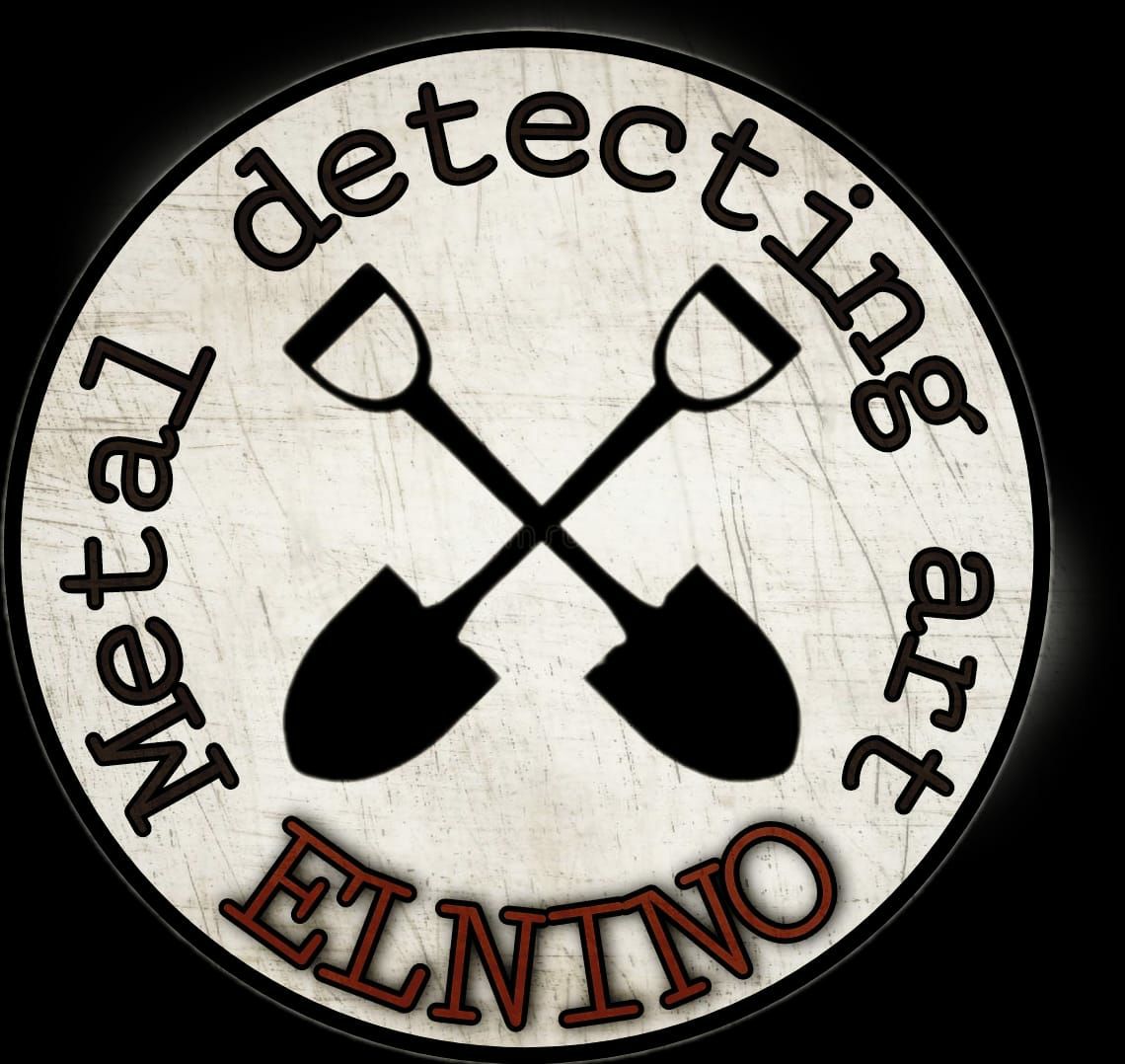

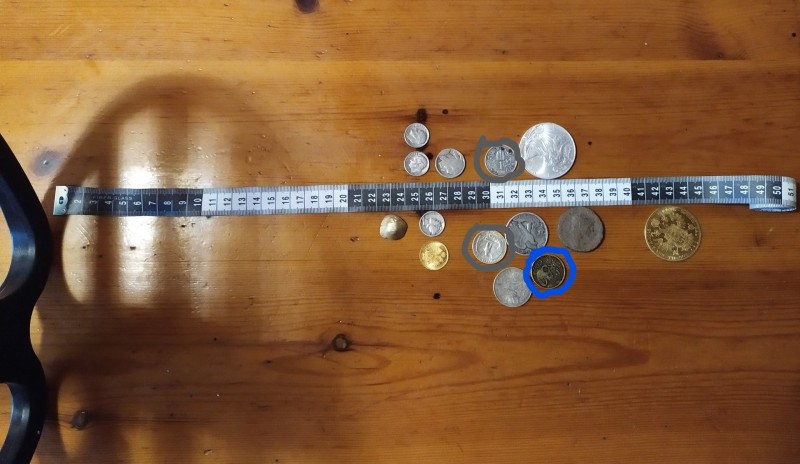
.thumb.jpg.db5c4f0c4e2fa84b9f600c0e223412df.jpg)
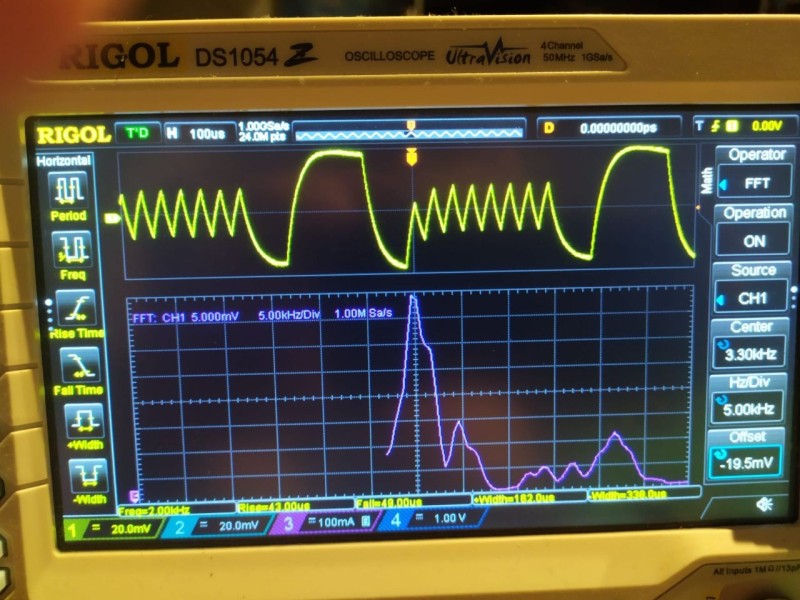
.thumb.jpg.f81402f888640192dedc9b0b1e1d9981.jpg)
.thumb.jpg.7c881acdb71adb2fe5382387acc3e4ce.jpg)
.thumb.jpg.f98abe5c9e672f04b931604f57986251.jpg)
.thumb.jpg.b3f0875fbdeff81b065fc758b405fa42.jpg)
